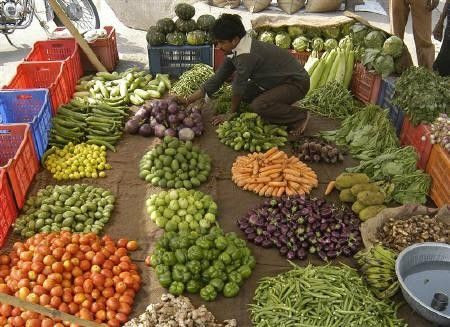Possible solutions to high food inflation

India's food inflation eased for the second straight week due to lower fruit and vegetable prices, data showed on Thursday, but an acceleration in headline inflation in December is likely to put pressure on the central bank to raise rates at a policy review next week.
At 15.5 percent, food inflation remains high but has eased from a one-year high of 18.32 percent touched in late December, mainly due to a spike in onion and tomato prices.
Here are some facts about what led to the sudden rise in food prices and how the government is likely to deal with it.
THE PROBLEM
Food inflation has been in double digits for most of the past year despite a series of central bank rate hikes, prompting a central bank deputy governor to say that monetary tools are largely ineffective.
Unseasonal rains during the October-November harvesting season for onions in the key growing states of Maharashtra, Andhra Pradesh, Karnataka and Tamil Nadu spoilt much of the summer crop, causing a supply shortage.
Other vegetables like potatoes and tomatoes, which are grown around the same regions, also suffered.
While vegetable prices rose by 65 percent, onion prices skyrocketed nearly 100 percent on the year, the latest government data showed.
Vegetables are part of the food basket which makes up more than 14 percent of the wholesale price index (WPI), which is the most widely watched gauge of prices in India.
SHORT FIXES
Vegetables like onions and potatoes are perishable items, so imports are not feasible. As the government does not procure perishable commodities, unlike wheat and rice, there is no buffer stocks for release during a supply crunch.
India recently contracted 1,000 tonnes of onion imports, but that is unlikely to help much as the supply shortfall is estimated at 1 million tonnes this year.
A tweaking of duties may not help either as most of India's vegetable demand is met by local produce.
LATE CROP BOON
Cracking down on hoarders may help, even though that measure has yielded limited success so far.
But, the gradual arrival of a late harvest of onions, tomatoes and potatoes to the markets has slightly eased the supply crunch. The late harvest accounts for a quarter of the annual produce of these vegetables.
The government still estimates a shortfall of 1 million tonnes in onions this year, which is expected to keep prices high for some time. Food inflation is expected to stay in double digits until March, analysts say.
EXPORT BAN
India has already scrapped duty on some vegetable oils and pulses and banned exports in them as the country is a net importer of these commodities. The measures have helped keep prices relatively in check.
But, as India imports half its requirement of edible oils, an element of imported inflation would seep through as global prices are on the rise.
The government can use tools like procurement price, called minimum support price in India, to incentivise producers to increase areas under cultivation.
BOUNTIFUL GRAINS
India's grain stocks stood at 47.1 million tonnes on Jan. 1 against a target of 20 million tonnes. The government has banned exports of wheat and most forms of rice as global prices are higher.
LONG-TERM SOLUTIONS
The government has a work-in-progress list for long-term supply-side solutions.
It has to pare the plethora of middlemen in the farm-to-fork chain by overhauling agricultural marketing regulations and introducing foreign direct investment in the multi-brand retail sector, both politically difficult to achieve.
But, by investing heavily in cold storage improvements and transport, the government could help avoid price spikes in perishables like vegetables.
With 60 percent of India's workforce engaged in agriculture, which accounts for barely 15 percent of India's gross domestic product, the government needs to bring in land reforms, especially to tackle the problem of low agricultural productivity stemming from small land holdings and leading to stagnant yields.
LIMITED IMPACT
Monetary measures are largely ineffective in controlling what is a supply-side problem but the Indian central bank may intervene for the seventh time within a year to tackle the knock-on effects of high food inflation.
Headline inflation in December accelerated to above 8.4 pct and the Reserve Bank of India is expected to raise rates by at least 25 basis points at its Jan. 25 policy review.
© Copyright Thomson Reuters 2024. All rights reserved.


















